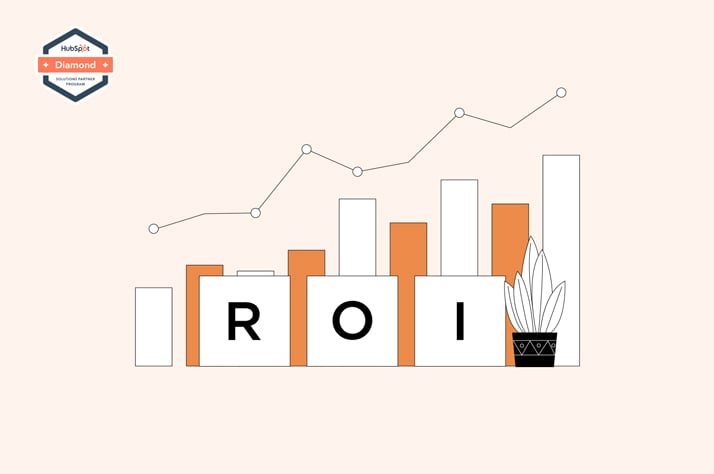Are you tracking the ROI of your marketing spend?
- Home
- Blogs

In HubSpot’s 2021 State of Marketing Report, it was noted that 4 in 10 marketers feel that it’s “extremely important” or “very important” to understand the ROI of marketing campaigns, whereas only 37% felt confident when making budget decisions for investing in campaigns that influence revenue.
Most marketing professionals will be familiar with the term ROI, or return on investment. It’s a common metric that marketers use to measure the success of their marketing campaign, and it’s certainly something that management will want to know to assess if marketing is doing its job in creating sales. It’s a way to calculate how much profit is created for each dollar invested in your marketing strategy.
By calculating the ROI, marketers can show the real value of a successful marketing campaign, and have accurate data to prove how much revenue can be attributed to their campaigns.
How to calculate the ROI and ROAS
Return on investment (ROI) and return on ad spend (ROAS) are both important metrics to calculate. ROI is the profit over the total cost of your marketing campaign, and includes costs such as media spend, people cost, and everything else that goes into setting up and running a campaign.
The formula for ROI is simple: (net profit / net spend) x 100%
ROAS simply looks at the media spend, excluding other costs. It is the revenue made from your ads over the amount spent directly on ads. ROAS can tell you if your advertising campaign is bringing in revenue, but it doesn’t show exactly how profitable your ads are, as it does not consider all costs in setting up the campaign.
Here is the formula for ROAS: (revenue from ads / advertising spend) x 100%
Since ROI is the most accurate measurement of how much revenue your marketing has brought in, that’s what we’ll talk about in the rest of this article.
What should you consider when calculating ROI?
Calculating ROI for your marketing campaigns is not always straightforward, especially if you’re measuring the effectiveness of content marketing strategies such as blogs, emails and video campaigns.
We’ve highlighted a few factors that should be considered when calculating the ROI.
Time: Your time should be accounted for, which includes creating the initial strategy for the campaign, creating the marketing materials, initial set-up, and ongoing management of the campaign.
Total Production Costs: Media spend, software, and any suppliers that you have engaged for the campaign.
Financial Profit: The financial profit is one of the main things to consider when determining your ROI. This refers to the net profit after deducting your costs.
Non-Financial Returns: Non-financial returns are just as important as financial returns. Things like brand awareness, engagement, and website traffic are all important results that can be used to measure success. Whilst they may not result in revenue straight away, they are a great way to stay connected with your audience and will eventually contribute to revenue. HubSpot offers a great way to include these metrics into your ROI reporting, as it attributes metrics such as page views and social media engagements to conversions.
Page Analytics: Use a tracking URL to connect your page to an analytics tool such as Google analytics. This way, you can track the traffic to your landing page and number of sales generated.
Tools to measure ROI
As mentioned above, the success of a campaign isn’t just about the revenue it generates. The goal of some campaigns might be to increase brand awareness, social media engagement, or other metrics that are important to you and your business goals.
Keeping track of conversions can be tricky when you are juggling multiple goals that are often calculated in different ways. Fortunately, there are several tools available for marketers to use, making it easier to track and report on campaigns, and ultimately measure your ROI.
Google Analytics
Google Analytics is an awesome tool (and it’s free!) that gives you insights into your web traffic, traffic sources and other metrics such as bounce rates, website conversion and ecommerce performance.
CRMs
More than 60% of marketers use a built-in marketing or CRM software reporting tool. A CRM such as HubSpot can do what Google Analytics does and more. It allows you to track a wide range of data such as lead information, revenue, data from different campaigns and even give you control over your customer journeys. We’re HubSpot Diamond Solutions Partners here at ALYKA, and can say that the reporting functionality that HubSpot offers is second to none!
Spreadsheets
While there are many advanced tools available on the market, a spreadsheet is still a great tool to keep track of your campaign performance. A simple Google Sheet or Microsoft Excel spreadsheet can go a long way in keeping track of your ROI on a more frequent basis, as long as you update the data in a timely manner. Because you can easily use formulas in a spreadsheet, you can keep track of multiple metrics at once on top of your ROI. The downside is that you’ll have to manually input data from your sources.
A good report on ROI needs good data, and an understanding of what data is important. Not sure if you’re collecting the right data? Our Digital Maturity Index questionnaire is a great place to start to see how you shape up in the digital landscape. Complete yours here.
